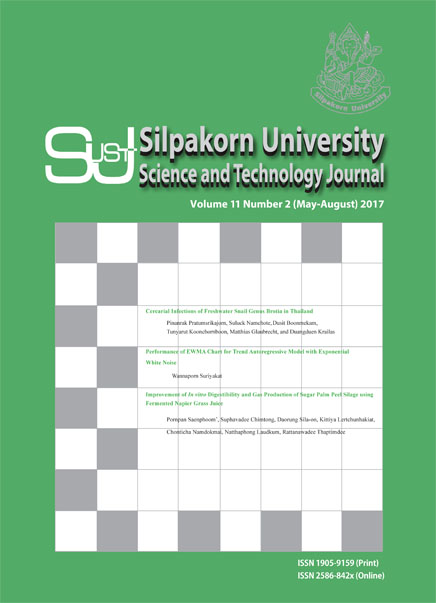Improvement of In vitro Digestibility and Gas Production of Sugar Palm Peel Silage using Fermented Napier Grass Juice
Main Article Content
Abstract
The objective of this study was to improve sugar palm peel silage using fermented Napier grass juice. Fermented Napier grass juice without sugar and with 1% glucose, 1% sucrose, 3% glucose, 3% sucrose, 5% glucose and 5% sucrose were prepared. Results showed that pH values of the fermented juices were 3.94 - 5.72. The highest total sugar content (136.30 mg/ml) was obtained from fermentation with 5% sucrose. In addition, fermentation without sugar gave higher lactic acid bacteria (15.17 × 106 cfu/ml) and aerobic bacteria content (19.23 × 107 cfu/ml) than other treatments while fermentation with 3% glucose gave the highest yeast and fungi count (22.37 × 107 cfu/ml). Therefore, the fermented juice without sugar was further used to improve the fermented sugar palm peel. Sugar palm peel silages without fermented juice and with 1% fermented juice and 1% molasses were prepared. Results showed that adding 1% fermented juice gave the lowest pH at day 7 and 14. Adding 1% molasses resulted in higher crude protein and lower hemicellulose and cellulose contents than other treatments. In vitro dry matter digestibility of samples with 1% fermented juice and 1% molasses at day 7 were significantly higher than sample without fermented juice. Similarly, gas production of sugar palm silages was significantly different among treatment. Gas production of sugar palm peel silages was highest at day 7. Based on the results, it can be concluded that fermented Napier grass juice was suitable for improving sugar palm peel silage.
Downloads
Article Details
References
AOAC. (1990). Official Method of Analysis. Association of Official Analytical Chemists, Washington, DC.
Bureenok, S. (2011). Applying fermented juice of epiphytic lactic acid bacteria (FJLB) as a new additive in tropical crop silages. Khon Khaen Agriculture Journal, 39, 85-98.
Bureenok, S., Suksombat, W., & Kawamoto, Y. (2011). Effect of the fermented juice of ephiphytic lactic acid bacteria (FJLB) and molasses on digestibility and rumen fermentation characteristics of Ruzi grass (Brachiaria ruziziensis) silages. Livestock, 138,266-271.
Chanprecha1, P., Saenphoom, P., Sittiya, J., & Chimtong, S. (2016). Effects of grass type on fermented juice quality. Khon Kaen Agriculture Journal, 44(Supplement 1), 19-24.
Hill, J. G., Xiao, Q., & Bali, A. S. (2001). Effect of inoculation of herbage prior ensiling with Streptomyces achromogenes ISP 5028 on chemical composition of silage. Animal Feed Science Technology, 80, 83-96.
Kozaki, M., Uchimura, T., and Okada, S. (1992). Experimental Manual of Lactic acid bacteria. Tokyo: Asakurashoten, pp. 6-16.
Makkar, H. P. S., Blümmel, M., & Becker, K. (1995). Formation of complexes between polyvinyl pyrrolidones or glycols and tannins, and their implication in gas production and true digestibilit in In vitro techniques. British Journal of Nutrition, 73, 897-913.
McDonald, P., Henderson, A. R., & Herson, S .J. E. (1991). The Biochemistry of Silage, 2nd ed., Marlow: Chalombe Publications.
Naknean, P., Meenune, M., & Roudaut, G. (2010). Characterization of palm sap harvested in Songkhla province, Southern Thailand. International Food Research Journal, 17, 977-986.
Pasebani, M., Yaakub, H., Alimon, A. R., & Sijam, K. (2011). Effect of epiphytic lactic acid bacteria isoll ate from guinea grass on nutritional value of the silages. African Journal of Agricultural Research, 6(19), 4447-4450.
Pereira, E. S., Mizubuti, I. Y., Ribeiro, E. L. A., Neiva, J. N. M., and Pimentel, P. G. (2013). Estimative of the nutritional value of agroindustrial byproducts by using In vitro gas production technique. Semina: Ciencias Agrarias, 34(1), 391-398.
Rungrodnimitchai, S. (2011). Novel source of pectin from young sugar palm by microwave assisted extraction. Procedia Food Science, 1, 1553-1559.
Saenphoom, P., Chimtong, S., Chaokaur, A., Kutdaeng, D., Chanprecha, T., & Seesawhea, Y. (2016). Nutritive value of fermented sugar palm peel with pineapple peel. Silpakorn University Science and Technology Journal, 10(1), 32-37.
Santoso, B., Hariadi, B. Tj., Sabariah, V., & Sraun, T. (2014). Fermentation quality and in vitro nutrient digestibility of fresh rice straw-based silage treated with lactic acid bacteria. Media Peternakan, 37(2), 115-120.
SAS. (1998). User’s Guide: Statistics, 9.2 ed., North Carolina: SAS Institute.
Shultz, T. A., Ralston, A. T., & Shultz, E. (1974). Effect of various additives on nutritive value of ryegrass straw silage. I. Laboratory silo and in vitro dry matter digestion observations. Journal of Animal Science, 39, 920-925.
Sommart, K., Parker, D. S., Rowlinson, P., & Wanapat, M. (2000). Fermentation of characteristics and microbial protein synthesis in an In vitro system using cassava, rice straw and dried ruzi grass as substrates. Asian-Australasian Journal of Animal Science, 13(8), 1084-1093.
Steel, R. G. D., & Torrie, J. H. (1980). Principles and Procedures of Statistic a Biometrical Approach, 2nd ed., New York: McGrow-Hill.
Van Soest, P. J., Robertson, J. B., & Lewis, B. A. (1991). Methods for dietary fiber, neutral detergent fiber and non-starch polysaccharides in relation to animal nutrition. Journal of Dairy Science, 74, 3583-3597.
Yahaya, M. S., Goto, M., Yimiti, W., Gamo, Y., Kim, W., Karita, S., & Smerjai, B. (2004). Epiphytic microbiota on tropical Tinaroo legume (Neonotonia wightii) as revealed by denaturing gradient gel electrophoresis (DGGE) and scanning electron microscopy (SEM) and their effects on silage fermentation and ruminal degradability. Journal of Animal and Veterinary Advances, 3, 339-347.


